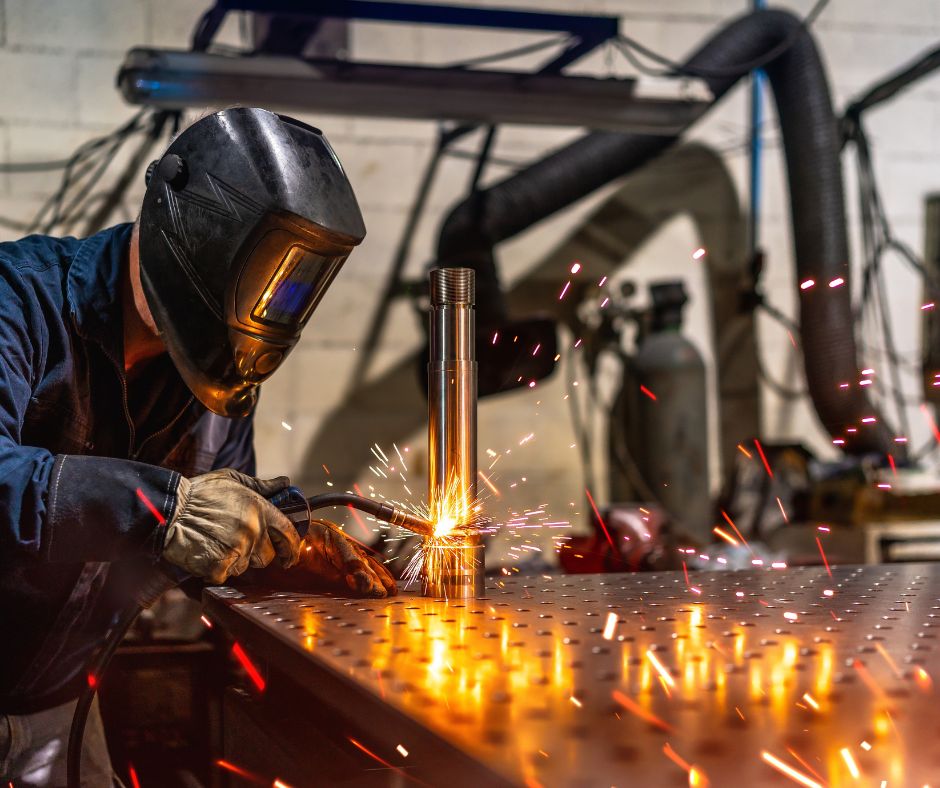Welding helps shape the world we know—from buildings and bridges to cars and pipelines. But while welding can open doors to creative, hands-on careers, it also comes with risks. That’s why safety should be a top priority for every welder, whether you’re just starting or have years of experience under your belt.
At Stratford Career Institute, we offer a convenient and affordable online welding course that introduces students to the fundamentals of the trade, including welding safety. Our self-paced program helps you explore whether welding could be the right fit for your future, whether as a hobby or the first step toward a new career. It is a great start to help you build a foundation in welding basics.
Let’s examine the importance of welding safety precautions, welding safety tips, and how proper training can make all the difference.
Why Taking Welding Safety Precautions Matters
Welding involves high temperatures, intense light, electrical currents, and flammable materials, posing serious dangers if improperly handled. Even a single moment of carelessness can result in burns, eye injuries, electric shock, or respiratory problems from inhaling fumes.
Our welding safety tips below aim to build long-term habits that protect your health, co-workers, and workspace. Whether you’re learning welding at home or planning to enter a trade school or apprenticeship, understanding and practicing safety is the foundation of responsible welding.
By staying alert and following key safety guidelines, you can reduce risk and build confidence while learning and growing your skills.
10 Welding Safety Rules to Follow
Developing a strong safety mindset is critical. The following rules should become second nature to anyone working with welding equipment.
Let’s break down these 10 welding safety rules, their meaning, and why they matter.
1. Always Wear Proper Protective Gear
Protective equipment is your first line of defense, making it one of the most essential welding safety rules. They include:
- A welding helmet,
- Flame-resistant gloves,
- A long-sleeve welding jacket,
- Safety boots with steel toes,
- Ear protection, and
- Respirators.
Protective equipment directly impacts welding safety by minimizing physical harm and long-term health effects.
2. Work in a Well-Ventilated Area
Welding produces toxic fumes and gases. Without adequate airflow, these can build up quickly and cause respiratory problems or long-term health issues.
Use fume extractors, fans, or weld outdoors when possible. Make sure your workspace meets ventilation standards before you start.
3. Inspect Equipment Before Each Use
Before every session, check your tools for wear, frayed cables, damaged hoses, or gas leaks. Faulty equipment increases the chance of accidents, including electric shock and fire. Regular maintenance helps keep your gear safe and functional.
4. Keep Your Workspace Clean and Clutter-Free
A tidy work area minimizes fire hazards and reduces the risk of tripping or knocking things over. Remove flammable materials like paper, wood, and oil-soaked rags, and make sure fire extinguishers are within reach.
5. Use Fire-Resistant Materials and Shields
Make sure your surroundings are fire-safe. Use welding blankets or curtains to block sparks, and position fire-resistant materials around your welding area. They also help prevent fires from spreading if stray sparks fly.
6. Follow OSHA Welding Safety Guidelines
The Occupational Safety and Health Administration (OSHA) sets national standards to protect welders from serious injuries. These include requirements for proper ventilation, fire prevention, and the proper use of personal protective equipment (PPE).
Reviewing OSHA’s welding safety rule can help you stay informed and work more safely.
7. Never Weld Near Flammable Liquids or Gases
Welding around fuel tanks, gas cylinders, or chemical storage areas can be incredibly dangerous. Sparks or heat can ignite flammable vapors, even if they aren’t visible. Always check your environment before starting.
8. Protect Others
Welding can harm people nearby. Use welding curtains or shields to protect others from arc flash and hot metal. Display warning signs or limit access to the area while you’re working.
9. Be Aware of Heat-Related Injuries
Welding generates extreme heat, not just at the arc but on surrounding metal surfaces. Use caution when touching recently welded items, and always wear heat-resistant gloves. Burns are one of the most common welding injuries.
10. Know Emergency Procedures
If something goes wrong, you need to act fast. Know the location of fire extinguishers, emergency exits, and first aid supplies. Learn basic first aid to respond appropriately in case of an injury.
Explore Welding with Stratford Career Institute
If you’re curious about welding but unsure where to start, Stratford Career Institute offers an affordable and flexible way to test the waters.
Our welding course is an excellent introduction for hobbyists, DIYers, or anyone considering entering the trades. Our course can help you learn the fundamentals, including welding safety rules, equipment basics, and welding techniques.
You can study on your schedule, with support available if needed. There’s no commuting, no pressure, and no prior experience required.
Check out Stratford Career Institute’s online welding course today and take the first step toward a foundation in this hands-on field.


